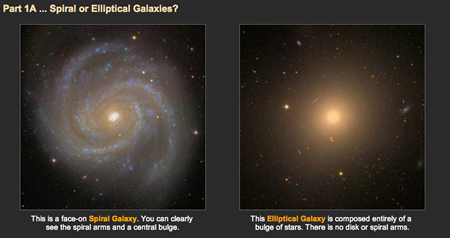New Scientist reported today that cosmologist Kate Land of the University of Oxford is exposing her research project to the collective intelligence of humanity.
In 2005, Land noticed an unexpected alignment of spots in the cosmic background radiation, which seems to defy the standard model of cosmology. Earlier this year, New Scientist reported that a study of 1660 spiral galaxies suggested the galaxies were oriented along this so-called “axis of evil”. Land says, “It’s a massive and alarming claim, which if true, forces us to come up with a new framework for cosmology.”
Land now wants the public to help verify this by visually classifying galaxy orientations. “We could try to program a computer to do this, but because humans are good at picking out fine details, it turns out it’s better to eyeball it,” says Land.

Humans are better at recognizing patterns in images than computers.
Galaxy Zoo does just that. Opened for business today, members will be tasked with identifying images of galaxies as spiral or elliptical. Humans can do this much better than computers since pattern recognition is the strength of our brains, whereas computers are good at computation. You are also asked to determine if the rotation is clockwise or counter-clockwise. After going through the tutorial, you are asked to take a 15-image trial test. To advance to the live project, you have to get at least eight correct.
There is a much richer explanation about the science behind this work. As far as collective resource projects go, this is far more tangible and engaging—you can even keep track of your own galaxies and statistics—than the SETI @Home distributed computing project or even Assignment Zero. It’s probably a better use for down time and procrastination periods than George the Bluebit.
1 reply on “Connecting the Dots in the Sky”
One of the better blogs in existence, Read/Write Web, covered Galaxy Zoo today. Josh Catone included a more extensive list of distributed projects.